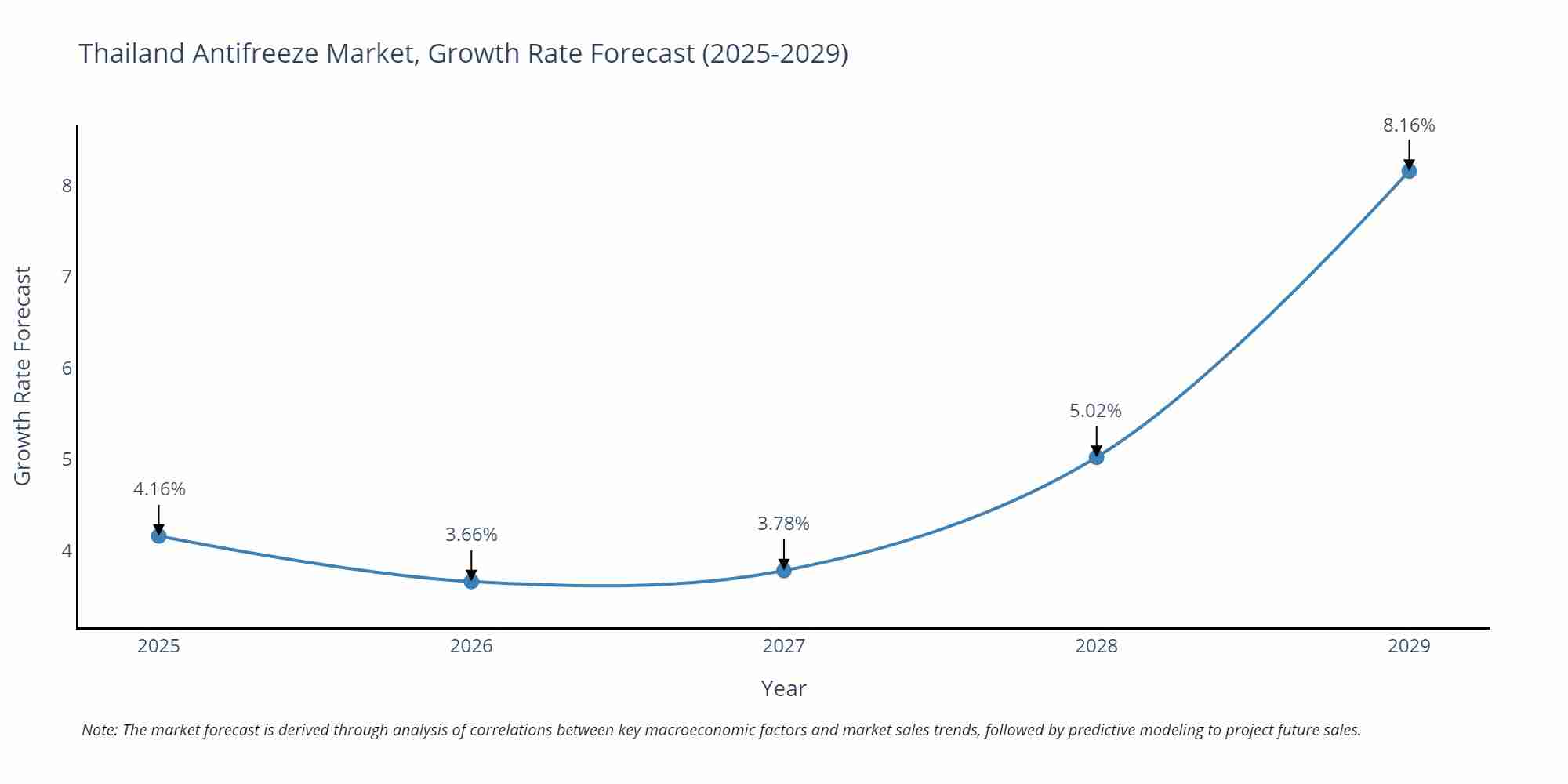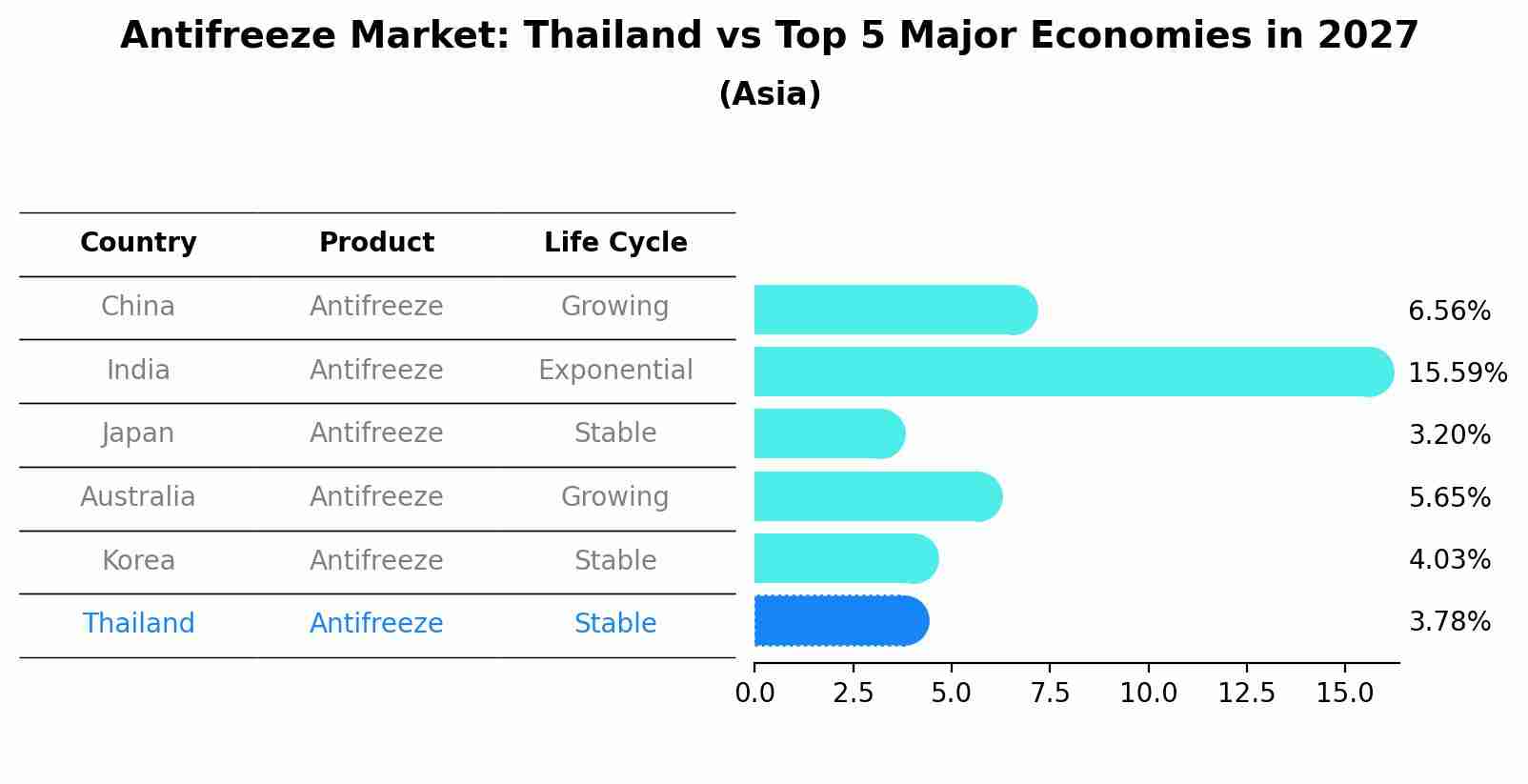Thailand Antifreeze Market (2025-2031) Outlook | Companies, Trends, Forecast, Growth, Share, Analysis, Size, Industry, Revenue & Value
| Product Code: ETC127708 | Publication Date: Jul 2023 | Updated Date: Apr 2025 | Product Type: Report | |
| Publisher: 6Wresearch | Author: Ravi Bhandari | No. of Pages: 70 | No. of Figures: 35 | No. of Tables: 5 |
Thailand Antifreeze Market Size Growth Rate
The Thailand Antifreeze Market is projected to witness mixed growth rate patterns during 2025 to 2029. The growth rate starts at 4.16% in 2025 and reaches 8.16% by 2029.

Antifreeze Market: Thailand vs Top 5 Major Economies in 2027 (Asia)
The Antifreeze market in Thailand is projected to grow at a stable growth rate of 3.78% by 2027, within the Asia region led by China, along with other countries like India, Japan, Australia and South Korea, collectively shaping a dynamic and evolving market environment driven by innovation and increasing adoption of emerging technologies.

Thailand Antifreeze Market Synopsis
The Thailand antifreeze market has experienced substantial growth in recent years. Antifreeze, a vital automotive fluid used to prevent engine overheating and freezing in colder climates, has seen increasing demand due to the expanding automotive industry in the country. As Thailand economy grows and disposable incomes rise, there has been a surge in the sales of automobiles, including passenger cars and commercial vehicles. This surge in vehicle ownership has significantly contributed to the increased demand for antifreeze products in the country.
Market Drivers
Several factors have been driving the growth of the antifreeze market in Thailand. Firstly, the automotive industry`s expansion and the rising number of vehicle registrations have led to a higher demand for antifreeze products. With more vehicles on the road, there is an increased need for effective engine cooling and freeze protection solutions, which antifreeze provides. Secondly, the government`s initiatives to promote the automotive sector and attract investments have stimulated market growth. Furthermore, advancements in antifreeze technology, such as the development of eco-friendly and long-lasting formulations, have also fueled market demand.
Challenges of the Market
Despite its growth, the Thailand antifreeze market faces certain challenges. One of the primary challenges is the presence of counterfeit and low-quality antifreeze products in the market. These substandard products can damage engines and pose safety risks, leading to concerns among consumers and affecting the market`s reputation. Additionally, fluctuations in raw material prices and supply chain disruptions can impact the cost of production and distribution, which may influence product pricing and market dynamics.
Covid-19 Impact on the Market
The Covid-19 pandemic had a notable impact on the antifreeze market in Thailand. The automotive industry experienced a slowdown during lockdowns and travel restrictions, which temporarily affected the demand for antifreeze products. As vehicle sales dipped, so did the consumption of antifreeze. However, with the gradual recovery of the automotive sector as restrictions eased, the market witnessed a rebound in demand. Furthermore, the increasing awareness of hygiene and sanitation during the pandemic also drove the use of antifreeze in disinfection solutions.
Key Highlights of the Report:
- Thailand Antifreeze Market Outlook
- Market Size of Thailand Antifreeze Market, 2024
- Forecast of Thailand Antifreeze Market, 2031
- Historical Data and Forecast of Thailand Antifreeze Revenues & Volume for the Period 2021-2031
- Thailand Antifreeze Market Trend Evolution
- Thailand Antifreeze Market Drivers and Challenges
- Thailand Antifreeze Price Trends
- Thailand Antifreeze Porter's Five Forces
- Thailand Antifreeze Industry Life Cycle
- Historical Data and Forecast of Thailand Antifreeze Market Revenues & Volume By Product for the Period 2021-2031
- Historical Data and Forecast of Thailand Antifreeze Market Revenues & Volume By Ethylene Glycol for the Period 2021-2031
- Historical Data and Forecast of Thailand Antifreeze Market Revenues & Volume By Propylene Glycol for the Period 2021-2031
- Historical Data and Forecast of Thailand Antifreeze Market Revenues & Volume By Glycerin for the Period 2021-2031
- Historical Data and Forecast of Thailand Antifreeze Market Revenues & Volume By Application for the Period 2021-2031
- Historical Data and Forecast of Thailand Antifreeze Market Revenues & Volume By Automotive for the Period 2021-2031
- Historical Data and Forecast of Thailand Antifreeze Market Revenues & Volume By Aerospace for the Period 2021-2031
- Historical Data and Forecast of Thailand Antifreeze Market Revenues & Volume By Industrial heat transfer and cooling applications for the Period 2021-2031
- Historical Data and Forecast of Thailand Antifreeze Market Revenues & Volume By Technology for the Period 2021-2031
- Historical Data and Forecast of Thailand Antifreeze Market Revenues & Volume By OAT for the Period 2021-2031
- Historical Data and Forecast of Thailand Antifreeze Market Revenues & Volume By HOAT for the Period 2021-2031
- Historical Data and Forecast of Thailand Antifreeze Market Revenues & Volume By IAT for the Period 2021-2031
- Thailand Antifreeze Import Export Trade Statistics
- Market Opportunity Assessment By Product
- Market Opportunity Assessment By Application
- Market Opportunity Assessment By Technology
- Thailand Antifreeze Top Companies Market Share
- Thailand Antifreeze Competitive Benchmarking By Technical and Operational Parameters
- Thailand Antifreeze Company Profiles
- Thailand Antifreeze Key Strategic Recommendations
Frequently Asked Questions About the Market Study (FAQs):
Thailand Antifreeze |
1 Executive Summary |
2 Introduction |
2.1 Key Highlights of the Report |
2.2 Report Description |
2.3 Market Scope & Segmentation |
2.4 Research Methodology |
2.5 Assumptions |
3 Thailand Antifreeze Market Overview |
3.1 Thailand Country Macro Economic Indicators |
3.2 Thailand Antifreeze Market Revenues & Volume, 2021 & 2031F |
3.3 Thailand Antifreeze Market - Industry Life Cycle |
3.4 Thailand Antifreeze Market - Porter's Five Forces |
3.5 Thailand Antifreeze Market Revenues & Volume Share, By Product, 2021 & 2031F |
3.6 Thailand Antifreeze Market Revenues & Volume Share, By Application, 2021 & 2031F |
3.7 Thailand Antifreeze Market Revenues & Volume Share, By Technology, 2021 & 2031F |
4 Thailand Antifreeze Market Dynamics |
4.1 Impact Analysis |
4.2 Market Drivers |
4.3 Market Restraints |
5 Thailand Antifreeze Market Trends |
6 Thailand Antifreeze Market, By Types |
6.1 Thailand Antifreeze Market, By Product |
6.1.1 Overview and Analysis |
6.1.2 Thailand Antifreeze Market Revenues & Volume, By Product, 2021-2031F |
6.1.3 Thailand Antifreeze Market Revenues & Volume, By Ethylene Glycol, 2021-2031F |
6.1.4 Thailand Antifreeze Market Revenues & Volume, By Propylene Glycol, 2021-2031F |
6.1.5 Thailand Antifreeze Market Revenues & Volume, By Glycerin, 2021-2031F |
6.2 Thailand Antifreeze Market, By Application |
6.2.1 Overview and Analysis |
6.2.2 Thailand Antifreeze Market Revenues & Volume, By Automotive, 2021-2031F |
6.2.3 Thailand Antifreeze Market Revenues & Volume, By Aerospace, 2021-2031F |
6.2.4 Thailand Antifreeze Market Revenues & Volume, By Industrial heat transfer and cooling applications, 2021-2031F |
6.3 Thailand Antifreeze Market, By Technology |
6.3.1 Overview and Analysis |
6.3.2 Thailand Antifreeze Market Revenues & Volume, By OAT, 2021-2031F |
6.3.3 Thailand Antifreeze Market Revenues & Volume, By HOAT, 2021-2031F |
6.3.4 Thailand Antifreeze Market Revenues & Volume, By IAT, 2021-2031F |
7 Thailand Antifreeze Market Import-Export Trade Statistics |
7.1 Thailand Antifreeze Market Export to Major Countries |
7.2 Thailand Antifreeze Market Imports from Major Countries |
8 Thailand Antifreeze Market Key Performance Indicators |
9 Thailand Antifreeze Market - Opportunity Assessment |
9.1 Thailand Antifreeze Market Opportunity Assessment, By Product, 2021 & 2031F |
9.2 Thailand Antifreeze Market Opportunity Assessment, By Application, 2021 & 2031F |
9.3 Thailand Antifreeze Market Opportunity Assessment, By Technology, 2021 & 2031F |
10 Thailand Antifreeze Market - Competitive Landscape |
10.1 Thailand Antifreeze Market Revenue Share, By Companies, 2024 |
10.2 Thailand Antifreeze Market Competitive Benchmarking, By Operating and Technical Parameters |
11 Company Profiles |
12 Recommendations |
13 Disclaimer |
- Single User License$ 1,995
- Department License$ 2,400
- Site License$ 3,120
- Global License$ 3,795
Search
Thought Leadership and Analyst Meet
Our Clients
Related Reports
- Canada Oil and Gas Market (2026-2032) | Share, Segmentation, Value, Industry, Trends, Forecast, Analysis, Size & Revenue, Growth, Competitive Landscape, Outlook, Companies
- Germany Breakfast Food Market (2026-2032) | Industry, Share, Growth, Size, Companies, Value, Analysis, Revenue, Trends, Forecast & Outlook
- Australia Briquette Market (2025-2031) | Growth, Size, Revenue, Forecast, Analysis, Trends, Value, Share, Industry & Companies
- Vietnam System Integrator Market (2025-2031) | Size, Companies, Analysis, Industry, Value, Forecast, Growth, Trends, Revenue & Share
- ASEAN and Thailand Brain Health Supplements Market (2025-2031) | Strategy, Consumer Insights, Analysis, Investment Trends, Opportunities, Growth, Size, Share, Industry, Revenue, Segments, Value, Segmentation, Supply, Forecast, Restraints, Outlook, Competition, Drivers, Trends, Demand, Pricing Analysis, Competitive, Strategic Insights, Companies, Challenges
- ASEAN Bearings Market (2025-2031) | Strategy, Consumer Insights, Analysis, Investment Trends, Opportunities, Growth, Size, Share, Industry, Revenue, Segments, Value, Segmentation, Supply, Forecast, Restraints, Outlook, Competition, Drivers, Trends, Demand, Pricing Analysis, Competitive, Strategic Insights, Companies, Challenges
- Europe Flooring Market (2025-2031) | Outlook, Share, Industry, Trends, Forecast, Companies, Revenue, Size, Analysis, Growth & Value
- Saudi Arabia Manlift Market (2025-2031) | Outlook, Size, Growth, Trends, Companies, Industry, Revenue, Value, Share, Forecast & Analysis
- Uganda Excavator, Crane, and Wheel Loaders Market (2025-2031) | Strategy, Consumer Insights, Analysis, Investment Trends, Opportunities, Growth, Size, Share, Industry, Revenue, Segments, Value, Segmentation, Supply, Forecast, Restraints, Outlook, Competition, Drivers, Trends, Demand, Pricing Analysis, Competitive, Strategic Insights, Companies, Challenges
- Rwanda Excavator, Crane, and Wheel Loaders Market (2025-2031) | Strategy, Consumer Insights, Analysis, Investment Trends, Opportunities, Growth, Size, Share, Industry, Revenue, Segments, Value, Segmentation, Supply, Forecast, Restraints, Outlook, Competition, Drivers, Trends, Demand, Pricing Analysis, Competitive, Strategic Insights, Companies, Challenges
Industry Events and Analyst Meet
Whitepaper
- Middle East & Africa Commercial Security Market Click here to view more.
- Middle East & Africa Fire Safety Systems & Equipment Market Click here to view more.
- GCC Drone Market Click here to view more.
- Middle East Lighting Fixture Market Click here to view more.
- GCC Physical & Perimeter Security Market Click here to view more.
6WResearch In News
- Doha a strategic location for EV manufacturing hub: IPA Qatar
- Demand for luxury TVs surging in the GCC, says Samsung
- Empowering Growth: The Thriving Journey of Bangladesh’s Cable Industry
- Demand for luxury TVs surging in the GCC, says Samsung
- Video call with a traditional healer? Once unthinkable, it’s now common in South Africa
- Intelligent Buildings To Smooth GCC’s Path To Net Zero


















